Betting on the Next Pope ... in Antwerp in 1559
7/5/2025
By Jeroen Puttevils
On 22 April 2025, just a day after Pope Francis I’s death, the sports betting agency Ladbrokes offered to bet on who would become the next Holy Father and what papal name the new Bishop of Rome would take upon election. For betting agencies, papal elections constitute one of their biggest non-sports events. Now that the conclave is about to start, speculation is at its zenith. This betting has a long pedigree dating back until at least the sixteenth-century when Romans, often through Florentine brokers active in the Roman Banchi (from the Ponte Sant’Angelo and the Zecca Vecchia (the Old Mint) to the Church of San Giovanni dei Fiorentini), gambled feverishly on the identity of the next pope and cardinals. Betting on the new cardinals was an annual event, while the election of a new Pontiff after the death of the former incumbent of the Holy See was of course a more random and thus an even more interesting event to bet on.
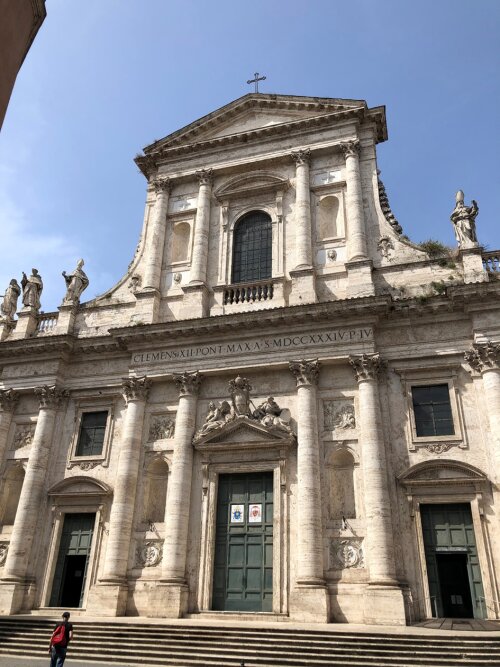
Church of San Giovanni dei Fiorentini in Rome, the epicenter of the Florentine Banchi neighborhood in the city, photo by the author in 2022.
How is this related to our Back to the Future project? Betting is clearly an action and a social practice in which ideas about and expectations for the future coalesce around a particular event. In betting on the new Bishop of Rome the bettors could (and did) use information and rumours about and coming out of the conclave to try and make money out of the papal election. In many cases, the bet relied on a careful assessment of balances of power within the Curia and the international politics that surely entered into the cardinals’ decision. Betting on a specific cardinal could also signify partisanship. In both cases, the act of betting gave the bettors so-called skin in the game, a financial stake in the outcome. Betting on the next pope was also a dynamic process since the end of the conclave was unknown. Therefore, the odds could change over time because of gossip and the betting behaviour of other players.
Gambling on the new Holy Father apparently reached far beyond the borders of Rome and the Italian peninsula. It is not a coincidence that the phenomenon also shows up in Antwerp in 1559, the focus of this blogpost. Antwerp had become one of the largest cities of commerce in Europe by that time and the large mercantile community in the Scheldt town was always hungry for the latest news. Combine that with one of the largest printing industries and you get a news hotspot. The Habsburg government was located in nearby Brussels and news and diplomats travelled at high speed between these two centers. The financial role of Antwerp for the Habsburg government turned Antwerp into a node in the network of international politics as well.
We know that Antwerp merchants and many others in the city were speculating in various financial enterprises, insurance, lotteries and bets on political events and the gender of unborn children. It is my research into lotteries that actually brought me to the 1559 papal betting in Antwerp. I was searching in the English State Papers Foreign: Elizabeth series for lotteries in England and the Low Countries when the following episode popped up on my screen.

Sir Thomas Chaloner, by an unknown Flemish artist, oil on panel, 1559, National Portrait Gallery London, NPG 2445
On August 31 1559 Sir Thomas Chaloner, Queen Elizabeth I’s ambassador to King Philip II of Spain at Brussels, wrote from Brussels to Secretary of State William Cecil, Lord Burghley, about the news of the death of Pope Paul IV. In the morning of the day before Chaloner had received the news of the Pontiff’s death on August 18. So the news took twelve days to reach Brussels, quite fast by the speed standards of the time. Chaloner describes that all hell broke loose in Rome after Paul IV was summoned back to the Lord. The Roman people directed their fury – Paul IV was not very popular in Rome – at the Inquisition. Some letters received by Chaloner – so he received news from different sources – reported that the Chief Inquisitor was killed by the mob, according to other letters he was treated roughly and wounded. The mob also burned down all the records of the inquisition and set all the prisoners suspectos hereticæ pravitatis at large. One of these prisoners, according to Chaloner, was Thomas Wilson who Queen Elizabeth herself wanted to stand trial as a heretic in England but was in fact arrested and tortured in Rome by the Inquisition. Wilson later became Elizabeth’s Secretary of State. How futures could change! Another wild show of protest of the Roman crowds was the toppling of Pope Paul's statue on the Capitoline. The statue’s head served as a football for three days before it was thrown into the Tiber river. The events in the Vatican and Rome following the passing away of Pope Franciscus I were much more serene. Francis was in any case a more popular Holy Father compared to Paul IV and the Holy See was much more in charge than in 1559.
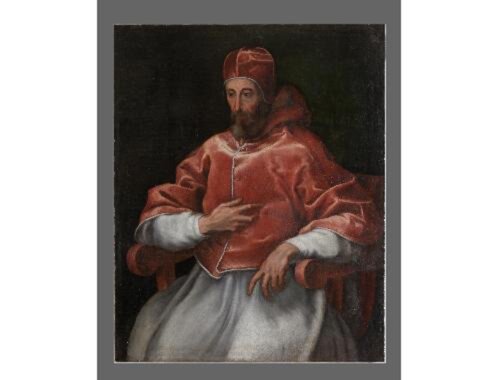
Pope Paul IV, c. 1560, after Jacopino Conte, Palazzo Ducale Mantova
In his letter, the English ambassador Chaloner then proceeds with details on the papabile, a term he uses and explains himself: “papabile (as they term it)”. One of the cardinals, Morone, is “papable” but he is also one of the prisoners released from the prison of the inquisition in the Castel Sant’Angelo. It is unlikely that his papal candidacy would survive further scrutiny. Cardinals Carpi (59 at the time), De Puteo (64), Mantua (Ercole Gonzaga, 53), and the Frenchman du Bellay (59 and Dean of the College of Cardinals) are mentioned as potential successors. Chaloner adds that they are considered too old to be eligible, while Cardinals Farnese and Ferrara, at 38 and 50 respectively, are deemed too young. Clearly, different age criteria than today.
The events following the death of a pope were extremely politically sensitive in the sixteenth century. Control over Rome and the Church was at stake — and this extended beyond the city itself, involving both religious and secular power in parts of Italy, Europe, and the European empires. At that time, all European monarchs sought to gather as much information as possible about the situation in Rome and actively tried to intervene in the decision-making process. Although the doors were closed, there were various ways to get small notes in and out of the conclave — for instance, through food deliveries or carrier pigeons. Numerous agents attempted to influence the voting behavior of cardinals, often through bribery. At this very moment, there are also attempts to discredit certain Cardinals by conservative Catholics, for example by publicizing the Philippine Cardinal Luis Antonio Tagle singing of John Lennon's Imagine [there's no heaven] (see The ultra conservatives wanting to make the Vatican great again – POLITICO). And President Donald Trump has distributed an AI depiction of himself as pope (Trump criticised after posting AI image of himself as Pope).
The news about the death of Paul IV will not have been a total surprise to Chaloner. In a letter of August 16, Cecil already writes that he had heard “that all the French Cardinals go to Rome, saving the Cardinal of Tournay, for the choice of a new PP. (Pope), the old being near or dead”. A letter of August 8 from the ambassador to France Nicholas Throckmorton to Queen Elizabeth also reported on the departure of the French cardinals to Rome “as the last Pope is either dead or on the point of it". Throckmorton gives a list of papabili too: “One of these Cardinals, Carpi, Moroni, Sancta-Fiore [Guido Ascanio Sforza di Santa Fiora], or Ferrara shall have the election at this time to be Pope”. In an earlier letter (4 August), Throckmorton writes that if the French succeed in making the Cardinal of Ferrara the new successor of Saint Peter, that would be the worst-case scenario for the English Queen.
In any case, Chaloner was very keen on informing Cecil and Queen Elizabeth I about ongoing events in Rome and about possible futures concerning the papacy. This is obviously not a coincidence given the English throne’s troublesome relations with Rome and the major continental powers: France and the Habsburg Empire. If one of these powers were to manage to influence the Curia and the election, the papacy could become another pawn for them to move on the geopolitical playboard. Since the secession of King Henry VIII, Elizabeth's father, relations with Rome had been rather troubled. It therefore mattered greatly who would become pope. The spread of Protestantism and the growing tensions between Catholics and Protestants made the papacy an even more significant matter in the sixteenth century.
The Back to the Future project uses merchant letters, while I have relied on correspondence of government officials for this blog. These letters too are exercises in future thinking. Letters are time capsules since they arrive later, in the future, and thus describe events that have already taken place, but the addressee may not have been aware of them yet. These letters also include predictions, expectations and hopes, like the merchant letters.
There is even more, and here we get to the betting on the next Bishop of Rome! In a post-scriptum to his letter, Chaloner added: “Upon the Bourse, the names of sixty-three Cardinals are set up in manner of a lottery at three crowns the head; whose chances upon him that shall be Pope shall win the lot. Some lay in lots for ten or twenty names, to be sure to light upon one.” The Bourse refers to Antwerp’s Bourse, for which a new building was constructed in 1532. The Antwerp Bourse as location for this betting enterprise was not an odd choice: it could accommodate a large number of persons, and it was already a place where speculation and games (dicing at the bourse was so often forbidden by the city authorities that it must have been a common event) took place.
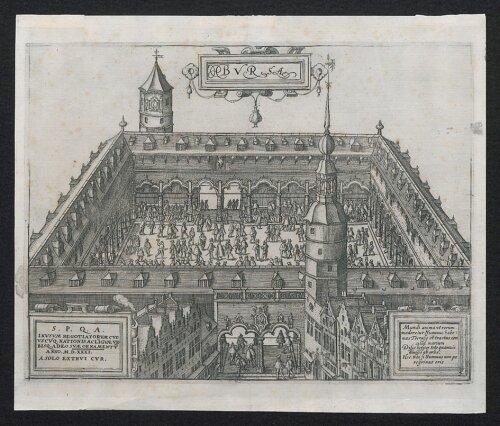
The Antwerp Bourse, c. 1612-1648, Special Collections University of Antwerp. https://anet.be/record/opacuaobj/tg:uapr:665/E
This “lottery” and its mentioning in the PS of Chaloner’s letter of August 31 might mean that either the news had reached Antwerp sooner than Brussels or that the lottery was already set up before the news of Paul IV’s death had arrived in the Low Countries. Visitors of the Antwerp Bourse could participate in this lottery or betting initiative by paying three crowns for a bet on one out of 63 cardinals. Chaloner’s description is unfortunately a bit too short to answer the questions that I still have about this bet: if you get the name of the next pope right, how does the payout work? Did the winners have to share the collected funds? Equally? Or according to the number of tickets one had bought on the winning cardinal’s head? Chaloner notes at the end that some bettors certainly try to diversify their risk by betting on several cardinals. The number of 63 names is intriguing as well, since historical research has determined the number of papabili to be around fifty.
All this 1559 betting fever took place at the Bourse while it was actually forbidden according to the ordinances of the Antwerp city government. In 1510 an ordinance was issued in which gossip about the pope and the emperor and betting on all kinds of political events were prohibited. This was repeated in 1521 and in 1571 the Customary Law of Antwerp explicitly forbade the betting, insuring of the health, lives and voyages of important personalities.
The 1559 Conclave opened on September 5, only on December 26 was the new pope, Cardinal Giovanni Angelo de Medici di Marignano elected, the longest conclave of the sixteenth century. Neither Chaloner nor Throckmorton included him in their lists of papabili. If the upcoming conclave for the successor of Franciscus I takes this long, I promise to write a bit more on the future expectations that affected the 1559 conclave.
Further reading
There is very detailed research on the Sede Vacante of 1559 on Wikipedia and on this website: Sede Vacante 1559.
For recent and rich work on betting on the next pope in Italy and Rome I refer you to the following works by John M. Hunt, Nicholas Scott Baker and Renaud Villard:
"Betting on the Papal Election in Sixteenth-Century Rome" by John M. Hunt
The market in the conclave: Gambling on election outcomes in Renaissance Italy | Request PDF
The Vacant See in Early Modern Rome – A Social History of the Papal Interregnum | Brill
Le conclave des parieurs | Cairn.info
Returning to the Home of the Father: Future Thinking and Papacy in late medieval Avignon
26/4/2025
By Nicolò Zennaro

Image 1. The Papal Palace in Avignon, photo by Jeroen Puttevils (July 2018)
“At 7:35 this morning, the Bishop of Rome, Francis, returned to the home of the Father.”
On the 21st April 2025, the Vatican camerlengo, Cardinal Kevin Ferrell, announced with these words the death of Pope Francis, the Holy Father of the Catholic Church. The news quickly circulated worldwide through all media, reaching every corner of our planet in a few minutes. After hearing about Pope Francis’ demise, the world, including 1.4 billion Catholics, is now wondering about the future of the Church. Who will be the next Pope? From what region of the world will he come from? Will he follow the (at times) more progressive politics of Francis? How will the new Pope affect world politics in such a critical situation as we live in now, with economic crises and wars threatening the global equilibrium? This high uncertainty has always characterised every death of any Pope in the past, probably since the times of St. Peter. When a Holy Father dies, an ideology, a political and religious vision of the world dies with him. Such a disruption leads believers and non-believers to imagine possible future scenarios for the Vatican State, Christianity, and themselves. All these expectations can be proved or disproved only by the white smoke following the decision of the conclave, namely the assembly of the College of Cardinals gathering to choose the new Pontiff. Looking at the uncertainty perceived by people facing the death of Pope Francis and waiting for the conclave’s decision, one can wonder: how did people experience these two events in the past? How fast was news concerning the health and demise of a Pope circulated? And finally, how could the death of a Pope and the election of a new one influence people’s future expectations and plans? This blog will ponder how the death of the Holy Father could have affected the future thinking of people from the past, and will wonder about possible situations that could occur today. We will do so by studying the correspondences written by merchants from the commercial network of the merchant of Prato, Francesco Datini (1335-1410), who left historians a huge archive preserved in the Archivio di Stato di Prato. Specifically, we will consider the correspondence written by Italian traders from Avignon, the capital of the Papacy between 1309 and 1377, and the capital of the Antipope from 1378 to 1403.

Image 2. Clement VII and the Duke of Anjou in Avignon
The most discussed “Papal death” in the letters preserved in the Datini archive of Prato is that of the Antipope Clement VII (1342-1394). Clement VII, born as Robert of Geneva, was elected Pope in Avignon on the 20th September 1378. His appointment represented an act of rebellion by French cardinals against the election of Pope Urban VI (1318-1389) on the 8th of April of the same year. The cause of such friction among cardinals was Urban’s choice to re-establish the Papal capital in Rome after sixty-eight years during which the Pope was based in Avignon. The rise of Clement VII signified the start of the Western Schism that would divide the Catholic Church from 1378 to 1403. This period consisted of the conflict between the Pope of Rome and the Antipope of Avignon to establish who was the real Holy Father of the Catholic Church. Clement VII faced Pope Urban VI and then Pope Boniface IX (1350-1404) with excommunications, military campaigns, and political attacks, but also through theological discussions. The final verdict on the two factions’ claims originating the Schism was issued by the University of Paris, which advanced three possible options to solve this situation: the abdication of both rivals, an arbitration by an equal number of judges appointed by the two factions, or the gathering of a General Council of the Church. Clement VII did not accept the solutions offered by the University of Paris and opted to find an alternative answer from the University of Avignon, without succeeding. The Cardinal Peter de Luna tried to support the Antipope’s claims, asking for the support of the French King Charles VI (1368-1422) against what was decided by the theologians in Paris, helped by the Duke John of Berry (1340-1416). Clement’s protests did not succeed, and the cardinals of Avignon pushed him to accept one of the solutions offered by the University of Paris. According to the sources, this situation caused a profound melancholy in Clement VII, leading to a heart attack that ended his life in the papal palace of Avignon on the 16th of September 1394.
Merchants informed Francesco Datini of the news the day after Clement VII’s demise (17 September), putting interesting concerns for Christendom’s future to paper. The merchant Tieri di Benci da Settignano wrote briefly about it:
Yesterday, on the 16th day of this month, it pleased our Lord to call Pope Clement to himself. May God forgive him his soul, and may He make and tell us what is good for Christendom and bring peace in everything.
Tieri hoped for God’s intervention for a brighter future, not reporting any more details concerning Clement’s death than its date. On the same day, the Avignon-based company of the Pratese merchants Francesco di Matteo Benini and Niccolaio di Buonaccorso, sent three copies of the same letter (!), containing a precise report of the event:
Yesterday morning, our Pope had a stroke that squeezed him in such a way that he lived perhaps an hour, and at about noon, he (the Pope) departed for God, who will receive him into Heaven, if it pleases Him. The stroke is believed to have been caused by melancholy, from which he had been suffering greatly for some time, for several reasons, and among others because of the events of the Schism.
These two merchants were interested in all the possible details concerning the dynamics behind the death of Clement VII. Francesco and Niccolaio describe the timing of the stroke and its potential cause, namely, the Pope’s melancholy. According to these two traders, Clement VII’s depression resulted from the events concerning the Schism, and mainly from the decisions taken by the University of Paris (“The University of Paris stimulated this melancholy”). It is interesting to see how God is not invoked to help the future that the merchants expected actually to occur, but to judge the Pope in his afterlife. These merchants’ uncertainty about the place in Paradise for the Pope shows hints of the negative perception of Francesco and Niccolaio of Clement VII’s conduct as Holy Father, and his choice of dividing Christendom in the name of his own interests. In a later part of this letter, the two Pratese merchants reported how people felt about Clement VII’s death and what they hoped for the future of the Papacy:
It was believed that his death was a chance to get rid of this Schism. He (Clement VII) is little mourned by everyone universally. May God provide a person (as Pope) with whom all Christians are comforted, and may He do so out of His mercy.
This letter ended with Francesco and Niccolaio’s expectations of the next Antipope elections, based on news they gathered, probably at the market or from people in Avignon:
Most hold for certain that if the King (Charles VI) and the University of Paris get this news, they will write to the College (of cardinals of Avignon) that another election should not be made for now. They will also write to Rome to see if an agreement (on the Schism) can be found. And although a new Pope will be elected, they (the cardinals) will elect him carefully, not to compromise their position. God makes the best happen, but many people would be happy.
People in Avignon were sure that the King of France and the University of Paris would find a solution to the split of Christendom caused by the Schism, trying to stop further elections of Antipopes. Indeed, most of the rumours expected a new discussion for finding an agreement between the Church of Avignon and that of Rome. If the French cardinals had elected a new Pope of Avignon, they would have done that carefully. All these expectations show how people hoped to see the end of the Schism, and how King Charles VI and the University of Paris were also pushing to see this solution happen.
According to the letters, the Pope was immediately buried on the 18th of September. We do not know any details from the letters concerning the funeral or the tomb of the Pope. Other sources report Clement VI’s body being placed in the cathedral of Avignon, then moved to the Church of Célestins on the 8th September 1401. Despite people’s expectations, we read from letters how the Schism was to be solved soon. Boninsegna di Matteo Boninsegna, the factor of Francesco Datini in Avignon, described the conclave gathered to elect a new Pope in a letter written on the 28th of September 1394:
On the 26th of September, which was Saturday, at the hour of vespers, twenty-one cardinals who assembled in peace and good concord, closed themselves in conclave, as is customary to do, diligently as never was seen to be done before. And then time passed, these twenty-one cardinals concorded in electing as Pope a cardinal from there (Avignon), Luna, on Monday, on the 28th of September. He is called Pope Benedict XIII and had, according to what is said, 19 ballots out of the 20 used to vote. Therefore, he (Benedict XIII) has been elected Pope in good agreement.
This description of the Avignonese conclave shows how quickly the French cardinals chose the next Pope (not even three days of conclave). The new Holy Father of the Church of Avignon was the aforementioned Cardinal Peter de Luna, who strongly supported the Schism. This choice reveals the path the Church of Avignon aimed to follow, contrasting with the King of France and the University of Paris. Despite these not-so-good premises for the Schism, Boninsegna asked God for “the grace for the future to have a shepherd well governing the Church of God”. On the same day, another member of the Datini company in Avignon hoped for the same, but with a more positive view on the newly elected Holy Father: “May God allow him to govern everything properly. Everything is doing well, and they will do so also in the future”.
The common agreement shown by the cardinals at the conclave and the desire to see a solution to the Western Schism formed positive expectations of Antipope Benedict XIII’s papacy and his possible plans for Christendom. However, these positive futures were disappointed soon. Benedict XIII continued the Schism and refused to come to an agreement with the Church of Rome. This Antipope brought even more disruptions to Christendom than his predecessor, and after five years of imprisonment in Avignon, he left the city in 1403. From that moment on, the Antipope Benedict XIII was often the target of attempted assassinations and poisoning. He died, away from France, in the Spanish city of Peniscola in 1423.

Image 3. The Coronation of Pope Benedict XIII
As we have seen from the letters of the Datini company’s members trading in Avignon, news concerning the death of a Pope and the election of a new one strongly influenced the future thinking of merchants and not only. People spread their hopes and expectations in the market, and generally perceive positively the changes coming from the election of a new Holy Father. It is interesting to see how the eschatological image of the Pope returning to God at his death remains unchanged over the centuries. As Clement VII “departed for God”, Pope Francis “returned to the Home of the Father”. The Pope's afterlife is perceived today similarly to six hundred years ago. Furthermore, we saw how a newly elected Pope brought and still brings new expectations for the world’s fate for believers and non-believers. Medieval people saw Clement VII’s death and Benedict XIII’s election as signs of a brighter future for them, in which the disruptions brought about by the Western Schism would have ended. Today, people hope that the next Pontiff will continue the more liberal politics of Pope Francis and increase the opening to reform shown by the Church during the last papacy. How do we know if these hopes will be proven or disproven? Is it possible to do so? The answer is clear: no. Sadly, we cannot forecast the future, and we can only imagine who will be the next Holy Father and hope that our most positive expectations can reveal themselves to be true.
Short Bibliography
Brun, Robert. Avignon Au Temps Des Papes: Les Monuments, Les Artistes, La Société. Bibliotheca Historica. Paris, 1928.
———. ‘Quelques Italiens d’Avignon Au XIVe Siècle. I. Les Archives de Datini à Prato’. Mélanges d’Archéologie et d’Histoire de l’Ecole Française de Rome 40 (1923): 103–14.
Creighton, Mandell. A History of the Papacy during the Period of the Reformation: Volume 1: The Great Schism – The Council of Constance, 1378–1418. Vol. 1. Cambridge Library Collection - European History. Cambridge: Cambridge University Press, 2011.
Frangioni, Luciana. ‘Avignon: The Beginnings’. In Francesco Di Marco Datini. The Man the Merchant, 249–80, 2010.
Images Sources
Image 1. Picture by Jeroen Puttevils
Image 2. Image from manuscript « Les Croniques que fist sire Jehan Froissart». Français 2664, see BNF Gallica, ID ark:/12148/btv1b60007003
Image 3. https://en.wikipedia.org/wiki/Antipope_Benedict_XIII#/media/File:Antipope_Benedict_XIII.jpg
Early Modern Motherhood
By Sanne Hermans
21/08/2024
Most people worldwide celebrate Mother's Day on the second Sunday in May. However, exceptions exist, such as in Antwerp, where mothers are honoured on August 15 during the Catholic feast of Assumption Day. This holiday prompted me to revisit my research on the relationship between motherhood, time, and, most importantly, the future. To explore this theme, I examined the letters of Hedwich de Bacher (1580-1609), the wife of jewellery merchant François Thijs. In 1605, she had a young son named Christopher and was expecting a baby girl. While residing in Amsterdam, she occasionally corresponded with her parents in Halberstadt. These letters offer valuable insights into her prospects as a young mother, starting with her reflections on pregnancy. On May 11, 1605, she wrote to her father, Andreas de Bacher—a court physician and thus the family’s trusted sounding board for all things medical—detailing the challenges of her second pregnancy:
"I have had chills every other day for the past 12 days, which have exhausted me so much that if this continues, I will have to remain in bed entirely. I haven't been able to eat any proper food for 6 or 8 weeks, and I don't know why I am now so sick. I didn't experience anything like this when I was pregnant with Christopher. I had hoped that once I reached the stage of carrying the child, it would improve, but it is still the same. May the dear God grant me health again."
Hedwich’s expectations, shaped by her first pregnancy with her son Christopher, did not align with the harsher reality of her second pregnancy. Time plays a crucial role here; it structures her experience of sickness and health, with Hedwich meticulously tracking changes in her body while looking forward with hope for recovery. Pregnancy, after all, is temporary, with a clear endpoint. Her outlook on delivery remains uncertain, but the possibility of dying in childbirth, a common fear, must have weighed on her mind. Actually, Hedwich did pass away in childbirth in 1609, which—at least for me—casts these motherhood narratives in a different light, including the following account from May 1605, where she shares her experiences with her toddler:
"My little son is becoming so adventurous with climbing that I could use an extra set of eyes to watch him. He also wants to say everything, as he and Liesbeth* together have the gift of gab. He talks twice as much as I do, and my head often aches."
* Liesbeth is the infant daughter of Hedwich’s father and his second wife, who was visiting Hedwich at the time. This makes Liesbeth Hedwich’s half-sister and Christopher’s aunt.
Here, Hedwich illustrates motherhood's daily challenges, emphasising how time intensifies these demands. The constant vigilance required to watch over her son and manage his endless chatter highlights the persistent nature of her maternal duties. Unlike pregnancy, there is no clear end, particularly for a mother without prior experience.
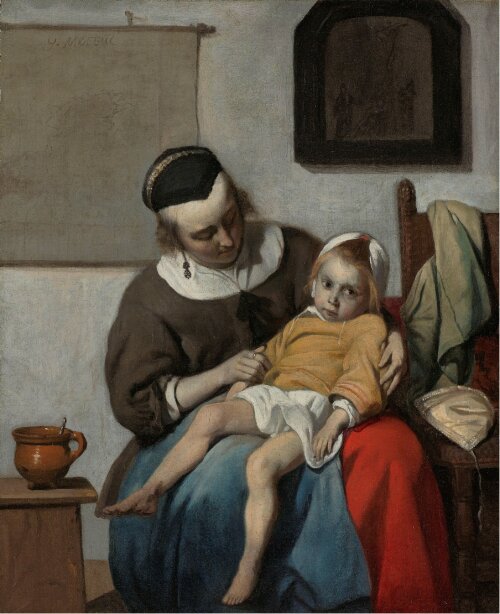
The Sick Child, Gabriël Metsu, c. 1664 - c. 1666 (Amsterdam, Rijksmuseum)
Once her daughter was born, the trials continued. On December 15, 1605, Hedwich wrote:
"My little girl is quite challenging, and until now, I have had little rest day and night. May God grant that she may increase in age, wisdom, and piety daily, growing for His honour and the joy of us all."
The temporal aspect of motherhood is again evident as she endures sleepless nights, hoping for her daughter’s swift growth and improvement. In Hedwich’s experience, time becomes both a marker of hardship and a measure of hope for the future. In the same letter, she refers to her, at the time, two-year-old:
"Our little Christopher often makes my head warm with all his chatter. He is such a lively boy, full of energy. I often wish you could see him. He talks from morning till evening about Grandfather, Grandmother, and Aunt Liesbeth; he wants to ride to Halberstadt and read an old letter where he imagines you all are mentioned. Every night and morning, instead of praying 'O God, Father,' he might say it 45 times for Grandfather and all the friends, naming them all. They both sleep by my bed, so I never lack company. The little one can annoy the big one well, so I must pay attention to them both."
Hedwich’s letters underscore the repetitive demands of early motherhood and her limited personal time, even at night. Yet, given her husband's constant travels, her children now provide companionship that would have otherwise been lost to solitude. This might suggest a more optimistic outlook on her future within the Thijs household, as her earlier letters often expressed feelings of loneliness. However, the following statement underscores her ongoing lack of "me-time" and concern about what might happen to her daughter if she doesn't intervene:
"I have more to write, but time is lacking, and I have a daughter whom I must attend to as her whim dictates, or she screams until her face turns black that I fear she might cry herself to pieces."
As mentioned, her husband was frequently away on long journeys, experiencing time differently as a parent than Hedwich. Although she occasionally received help from family and maidservants, her letters reveal that she still had to invest significant time caring for and raising her children—for their futures. I conclude with a final citation from an earlier letter, written in February 1605, to reinforce this point:
“I had to wean my son from breastfeeding 14 days after my dear husband’s departure on the 28th of January because I was losing most of my milk, and the child was nursing so strongly that I often felt dizzy, thinking I might faint. […] It has been 13 days now, and he has not been away from my breast, neither day nor night. I applied something bitter to my chest, and once he tasted it, he never wanted to nurse again, saying ‘da da kacke mem’, and now he refuses to drink with great effort. Thanks be to God, he is doing well, and people are amazed when I tell them that he is only 16 months old because he is so big, fat, and strong that he could easily be mistaken for a 2-year-old.”
This last narrative illustrates how motherhood is experienced through a constant negotiation of time—tracking milestones and adjusting routines. Also, it reflects societal perceptions of time, as others are "amazed" by the child’s size and strength relative to his age, highlighting external expectations of developmental markers.

A Mother Delousing her Child’s Hair, Known as ‘A Mother’s Duty’, Pieter de Hooch, c. 1660 - c. 1661 (Amsterdam, Rijksmuseum)
Perhaps this blog post could promote further research into the phenomenon of 'gendered temporalities’ since limited research has been done on early modern temporal experiences, including future orientations of women.
For those interested in exploring female temporalities across history, the following literature may be worth reviewing:
· S. Remijsen, “Women on Time: Gendered Temporalities in Greco-Roman Egypt”, 158-172. In: L. Dirven, M. Icks, S. Remijsen (eds.), The Public Lives of Ancient Women (500 BCE-650 CE) (Amsterdam 2023).
· Merry Wiesner-Hanks (ed.), Gendered Temporalities in the Early Modern World (Amsterdam 2018);
· Liana C. Sayer, “Gender, Time and Inequality: Trends in Women's and Men's Paid Work, Unpaid Work and Free Time,” Social Forces 84 (2005) 1: 285-303.
A Love made to be Eternal. A Story of Friendship, Death and Faith.
By Nicolò Zennaro
04/10/2023
On 16 July 1410, surrounded by relatives, friends and colleagues, the merchant Francesco di Marco Datini died at the age of seventy-five in his house in Prato, now the site of the State Archives. Of all the relatives, friends and partners who gathered around him in his last moments, the first to break the silence about Datini’s death in his correspondence was Lapo Mazzei, the notary and probably the only true friend of the deceased. Indeed, Datini was a man who was anything but easy-going because he was obsessed with controlling and his well-known tendency to fly into a rage quickly. Their friendship had begun in 1390: Francesco had been so fascinated by the text of a letter by Mazzei, read aloud by the city council, that he immediately wanted to meet its author. Theirs was a sincere and profound friendship. Mazzei was Datini’s confidant and one of the few people close to him to really care about his happiness. The two spent whole days discussing every conceivable subject, from literature to business, without the slightest hint of boredom. In the eyes of the notary, their friendship was irreplaceable and destined to last forever, surviving even death. Lapo wrote to Datini: “I shall never lose you. So much love has entered my bones and my soul.”. To make this possible, Mazzei, a man of faith, had tried for twenty years to persuade Francesco to repay the fortune God had given him in commerce with charity and donations to religious institutions in Prato and Florence to gain a place in Paradise. When his friend died, Lapo could not contain his sorrow, writing his first letter after the death of his friend to Cristofano da Barberino, manager of the Datini’s company in Catalonia. Lapo did not want to talk about his loss, but still mentioned Francesco “to whom God grant peace, and of whose death I will tell you little because he would want a full page: his sorrow, the sermons he preached, and his death, which was in our arms”. Depressed, Mazzei allowed his existence to be “led by time [...] without too much melancholy”. He admonished Cristofano to enjoy life and not to think that he had all the time in the world, as Francesco believed, “for whom it seemed a wonder that he should die”. Only a short time before his death, Lapo had managed to persuade Francesco to settle his accounts with God by making a bequest in his will of 70,000 florins to the city of Prato, to the religious institutions of the city and Florence and by establishing the Ceppo Nuovo, a secular charity foundation helping the poor people in Prato. In his testament, written down by Mazzei himself, Datini stated where he wanted to be buried:
In the first place, recommending his soul to God and the entire Celestial Court, he chose to have his body buried in the church of San Francesco di Prato when he died, in that place, with those devices and ornaments of the tomb, burial and funeral of the entire mortal body, and the expenses of these and other surrounding things, appropriate and used in similar things.
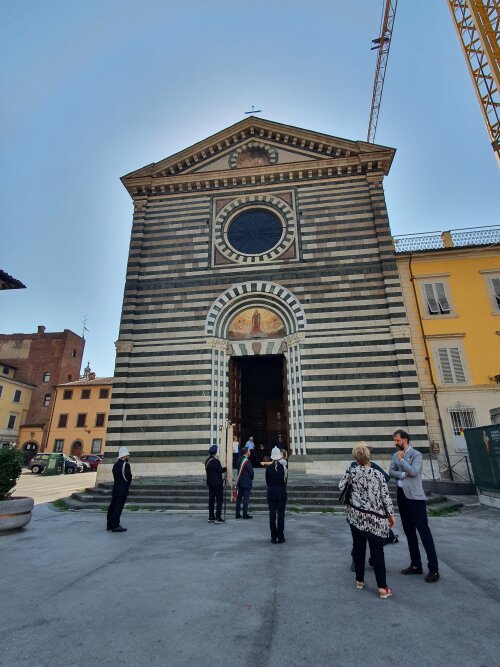
Image 1. The Church of San Francesco in Prato
To be even more sure of saving his soul, Francesco asked and paid for an annual mass to occur for eternity at the church where he would have rested. This is still the case today: every year, on 17 August, the day the merchant of Prato was buried, a memorial liturgy is celebrated in his honour. Having read part of his life through the letters written by him, his friend Lapo, his wife Margherita and the many business associates who corresponded with Datini, I decided to attend the event 613 years after Datini’s funeral. Indeed, I thought it would be a good opportunity to get even closer to the man who, although he lived centuries ago, has strongly influenced my life as a researcher. It was the 17th of August 2023. The Italian sun was unrelenting, and temperatures reached 37 degrees. Nevertheless, at 10 a.m., a few people stood before the Datini monument in front of the City Hall, the event’s starting point. There was a long silence, followed by a flower wreath laying at the base of the statue. The silence continued until the institutions of Prato moved to lead the procession towards the church of San Francesco. Once inside, more people joined in to attend the mass. The priest celebrated until he interrupted his sermon to explain how one of his confreres had asked him: “How come we keep celebrating this mass for Francesco di Marco Datini?”. The priest replied dryly that it was because of the deceased’s wish. This rather bland answer did not move the hearts of those present in the slightest, and when the ceremony ended, all left the church to seek shelter from the sun in their homes or the nearby cafés. Walking down the church’s steps, I kept wondering about it. I like to believe that the relationship between Francesco and Lapo is probably why this mass is still celebrated today. Just as Mazzei considered his friendship with Francesco eternal, so did the merchant. Convinced that the notary would undoubtedly end up in paradise for his exemplary Christian behaviour, Francesco made every effort to redeem himself. In this way, he could spend eternity with his beloved Lapo, talking honestly about everything, as they loved to do in their earthly life, living the friendship they hoped would last forever.
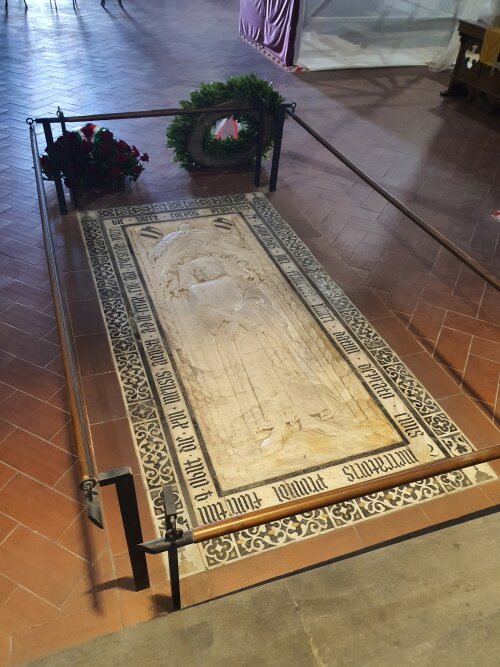
Image 2. Francesco Datini’s tomb in the Church of San Francesco
Short Bibliography
Crabb, Ann. The Merchant of Prato’s Wife. Margherita Datini and Her World, 1360-1423. University of Michigan Press, 2015.
Guasti, Cesare. Lettere di un notaro a un mercante del secolo XIV. II vols. Florence: Successori Le Monnier, 1880.
Origo, Iris. The Merchant of Prato: Francesco Di Marco Datini. London, 1957.
Sapori, Armando. ‘Economia e Morale Alla Fine Del Trecento. Francesco Di Marco Datini e Ser Lapo Mazzei’. In Studi Di Storia Economica (Secoli XII-XIV-XV), Terza., 1:155–79. Firenze: Sansoni, 1982.
Can natural disasters of the past tell us something about our future?
by Elisabeth Heijmans
07/09/2023
As the summer seems intent to never end, we cannot ignore the higher frequency of natural disasters and more extreme weather conditions such as storms and wildfires that have punctuated our summer. These disasters due to man-made climate change increasingly bring our attention back to the limits of our presence on earth and inevitably affect how we think about the future (of humanity). While scientific progress and our understanding of the causes of extreme weather conditions increase, we fear for our future and that of subsequent generations.
It is not the first time optimistic trust in progress clashed with the occurrence of natural disasters. Most famously in the mid-eighteenth century, the Lisbon earthquake is said to have impacted mentalities in a time of rationality and belief in scientific progress. The catastrophe took place on the 1st of November 1755 and affected the Iberian Peninsula and Lisbon primarily, but its impact (both material and psychological) was felt far beyond. Historians claim it was the strongest earthquake that Western Europeans have ever experienced.
That this extremely destructive and deadly event influenced the way people wrote about the future is visible in the letters written by the prominent Jewish merchant, Abraham Gradis who experienced the event from Bordeaux. The business correspondence of Abraham Gradis does not contain much emotional content or references to God, until the author writes about the Lisbon earthquake. When he learned that one of his close friends had drowned in the tsunami following the earthquake, he wrote to one of his correspondents “I admit that I am desperate about this accident, may God by his saint grace console the many afflicted and save us from similar misfortune”. On the same day, he wrote another letter appealing to God for help: “the famous earthquake caused much misfortune in Portugal, may God put his hand, we are penetrated with the pain of all the accidents”. Other letters penned in the following days mentioning the disaster include similar divine references.
Abraham Gradis clearly saw turning to God as the main way to protect him from a possible future event beyond human control. Clearly noticeable are the high frequency of terms related to his emotional state. The merchant talks about despair, affliction, misfortune, and pain. This choice of wording was not trivial. It was meant to convey sadness about the present situation and fear about the time to come.
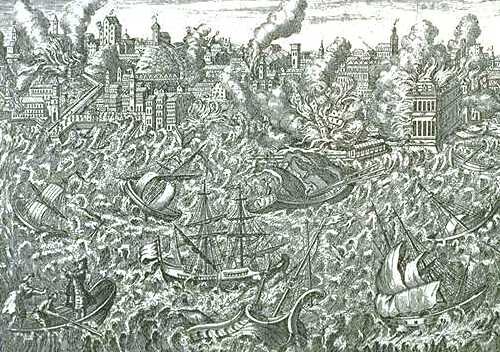
https://en.wikipedia.org/wiki/File:1755_Lisbon_earthquake.jpg
The communicated fear also concerned the possible impact on the merchant’s business: “I wish from the best my heart that you will have no interest in all the disasters that have occurred in Lisbon as a result of the furious earthquake that took place there on the first day of this month which will cause infinite damage to trade may God spare us from such accidents” or “may god put his hand and preserve your interests as well as ours against losses”. Abraham Gradis did not have any investments or partnerships directly in Lisbon, but bankruptcies and financial losses generated by the earthquake spread fast and could affect him in the long run. Here, we read unexpected combinations of words within the genre of the business letter, such as “best of our heart” to write about economic interests or “furious” to qualify the earthquake, showcasing the emotional impact of the disaster.
When writing about the Lisbon earthquake, all of Abraham Gradis future-oriented sentences mentioned God and were particularly dramatic and emotional in their content. The writer does not discuss the causes of the disaster, so it is impossible to know whether he thought the cause of the earthquake could be explained scientifically or if he saw it as a punishment from God as some of his contemporaries argued. What we know for certain, is that Abraham Gradis systematically turned to God for consolation and protection when writing about the earthquake.
Of course, all comparisons have their limits. While there are certainly many parallels to be drawn between the impact of the Lisbon earthquake and that of climate change-induced disasters, we should stress that current extreme weather conditions are due to man-made causes. This being said, the Lisbon earthquake remains instructive because it challenged the general scientific optimism of the Enlightenment and impacted the way people wrote about their future. Like in 1755, our current situation shows the limits of scientific progress and technologies. While we hopefully won’t revert to religious solutions, we cannot rely exclusively on scientific and technological progress. Instead, a profound change in our way of life and our relationship to nature is needed.
*Notes on sources: the letters of Abraham Gradis used here were transcribed by Mathieu Beaud, Cécile Robin, Pierre Gervais amd Dominique Margairaz, with the authorization of the French national archive. The projet 08-BLAN-0329-01 "Comptes et profits marchand d'Europe et d'Amérique, 1750-1815", dir. P. Gervais, Y. Lemarchand, D. Margairaz, http://marprof.univ-paris1.fr makes them available under creative commons licenses.
Further readings:
- Wilke, Jürgen, “The Lisbon Earthquake (1755)” in European History Online, Mainz , 2017. URL: http://www.ieg-ego.eu/wilkej-2014-en last consulted 02/09/2023.
- Braun, Theodore E. et al. (ed.): The Lisbon Earthquake of 1755: Representations and Reactions, Oxford, 2005.
- Van Asperen, Hanneke and Jensen, Lotte (ed.): Dealing with disasters from Early Modern to Modern Times: Cultural Responses to Catastrophes, Amsterdam, 2023.
Sinksenfoor ever
By Sara Budts
31/05/2023
Voor veel lokale voetballiefhebbers was afgelopen pinksterzondag een hoogst turbulente dag. Slechts 10 minuten voor het ultieme fluitsignaal liet Union Saint Gilles met een afgeweken balletje het Antwerpse droomscenario uit mekaar spatten. Hoewel er nog een waterkansje is (en Antwerpenaren doorgaans niet meer dan dat nodig hebben om overtuigd te zijn van eigen succes), grijpt Royal Antwerp FC wellicht net naast hun eerste titel sinds 1957. Gelukkig moesten de teleurgestelde supporters niet al te ver gaan om hun verdriet te verwerken. Op slechts een kwartier fietsen van het Bosuilstadion was de dag ervoor immers de Sinksenfoor van start gegaan: de uitgelezen plek om hun emotionele rollercoaster in te ruilen voor een fysiek exemplaar en hun opgekropte frustraties te wentelen in gesponnen suiker of een warm bad chocolade.
De Sinksenfoor is een monumentaal volksfeest dat tot ver buiten Antwerpen bezoekers trekt. Hoewel de meeste Antwerpenaren zich de recente omzwervingen van hun Foor nog wel herinneren (van de Leien naar de gedempte zuiderdokken en uiteindelijk Park Spoor Oost), is de jaarlijkse hoogmis van het opverteren een heel stuk ouder dan je zou denken. Dat ontdekte ik zelf pas vorig jaar, toen ik in mijn Engelse handelsbrieven uit de 16e eeuw een aantal verwijzingen tegenkwam naar ene "Sinxon fair". Het besef dat die mysterieuze Sinxon Fair wel eens de voorloper zou kunnen zijn van onze eigenste Sinksenfoor, overviel me veel later dan je zou mogen verwachten van iemand met een doctoraat in de historische taalkunde. Dat komt wellicht - toegegeven, het is een zwak excuus - omdat die Sinxon Fair waar mijn handelsfamilies het over hadden een heel ander doel leek te hebben dan de Sinksenfoor die ik zelf al eens bezocht had.

Foorwijf anno 2022
De fair die de Cely's en Johnsons frequenteerden in de late 15e en vroege 16e eeuw, was immers in de eerste plaats een kruispunt van internationale handel. De sinksenfoor maakte deel uit van een cyclus van vier jaarlijks terugkerende markten in Brabant die buitenlandse handelaars - vaak uit Engeland en Italië - in contact moesten brengen met lokale handelaars en ambachtslieden. De Sinksenfoor begon 15 dagen voor Pinksteren en duurde ongeveer een maand. Omdat de precieze datum van Pinksteren samen met die van Pasen fluctueert naargelang de maankalender, begon de Sinksenfoor ergens tussen 25 april en 29 mei, en liep ze tot minimaal 13 juni en maximaal 10 juli.
Naast de data van de jaarmarkt, onthullen de brieven ook wat er op zo'n markt gebeurde. Zowel de Johnsons als de Cely's zijn wolhandelaars, en voor hen was de markt in de eerste plaats een plek om hun wol en schapenhuiden te verkopen aan handelaars uit de Lage Landen. In 1480 slaagde George Cely er zo bijvoorbeeld in om zijn volledige voorraad middelmatige wol te verkopen aan ene Jan Van Der Heyden.
Daarnaast fungeerde de markt als deadline voor een heel gamma aan financiële transacties. In de wereld van de Cely's en de Johnsons verliep geldverkeer doorgaans via wisselbrieven die de houder op een bepaalde datum kon innen. Die datums volgden trouw het ritme van het marktseizoen en vielen niet zelden tijdens de Sinksenfoor. Ook de leningen die de handelaars opnamen bij elkaar liepen slechts een vooraf bepaalde termijn, en ook die termijnen vielen geregeld samen met een jaarmarkt. De correspondentie van de Johnsons vermeldt tussen 1543 en 1552 maar liefst 69 leningen en wisselbrieven die op de Sinksenfoor afliepen. Ook Richard Cely had in 1479 een lening te pakken gekregen die hij moest terugbetalen "at Synschon marte".
Een jaarmarkt als de Sinksenfoor was niet alleen een belangrijk deel van het zakenleven van de Johnsons en de Cely's, het was voor henzelf en hun familieleden ook een uitgelezen kans om allerlei exclusieve producten te kopen die weinig met wol te maken hadden. Toen John Johnson in 1546 terugkeerde van de markt gaf hij zijn vriend Henry Southwick "a bagge with monney, and spetialties of the Pasche, Sinxon and Bames maertes". Over het boodschappenlijstje van de Cely's weten we nog meer. In 1476 zakten de broers George en Robert Cely af naar de Sinksenfoor met op hun verlanglijstje onder meer een broek en een ring voor George, een gordel voor de vrouw van Robert en een havik voor een van hun andere broers. De havik bleek slechts 6 shillings duurder dan de gordel, waarvoor de mannen 10 shilling neertelden. Toen George vier jaar later terugkeerde naar dezelfde markt, had een modebewuste vriend hem verzocht om een stel mooie veren te kopen, ter versiering van zichzelf en zijn paard.
Het gamma aan producten waarvoor de Cely's naar de markt trokken geeft aan hoe divers het koopwaar en de bezoekers van zo’n jaarmarkt waren. De vroegmoderne voorloper van de sinksenfoor was geen saaie handelsbeurs: er was ook steeds een kermis, met eetstandjes, bezienswaardigheden, attracties, lokale en regionale handel. Ze werden goed bezocht door locals die kochten van locals. Je kon er wisselbrieven regelen, maar even goed een kip kopen of eens goed doorzakken. Bovendien was het fenomeen niet uniek voor Antwerpen - ongeveer elk stadje of dorp had een jaarmarkt. Het verschil tussen de jaarmarkt van een dorp als Berlaar en de Sinksenfoor was er voornamelijk eentje in schaal: die laatste was zo groot dat ze ook een internationale dimensie had.
Waar een goeie eeuw eerder Brugge nog het centrum van de textielhandel in de lage landen was, had dat zich rond 1500 verlegd naar Antwerpen. De Sinksenfoor won zo snel aan belang dat er rond het midden van de 16e eeuw bijna het hele jaar door marktactiviteiten plaatsvonden in de stad. Niet veel later kwam er aan die hoogdagen een einde toen de politieke situatie er te precair werd voor de handelaars door, onder meer, de beeldenstorm, de Spaanse furie en - als finale klap voor de internationale handel - het beleg van Antwerpen in 1584 en 1585. Ondanks die tegenvaller hield de Sinksenfoor hardnekkig vol te bestaan, zowel als handels- als entertainmenthub. In de eeuwen daarna transformeerde de grootste foor van het Stad door een klemtoonwisseling van handel naar amusement; eentje van wisselkoers naar paardenkoers, van geldgewin naar suikerspin, en van lamswol naar smoutebol. Wie de komende maand een hongertje wil stillen: u weet waar naartoe.
Hooray, it’s pi day!
By Sara Budts
14/03/2023
Today, the 14th of March, is Pi Day: the annually returning feast of the number π and, by extension, all things numerical. All around the globe, adepts of the noble art of mathematics throw parties to symbolically celebrate pi. Some hold competitions in which contestants try to memorize as many digits of the number as possible; others take a more pragmatic approach and honour pi as the proverbial Burgundians would do: by eating pies and pizzas, snacks that are reminiscent of "pi" in both their name and their shape. Let’s join the party and celebrate the circle for its contributions to a field that does not come to mind first when you think π: historical research!
One way in which circles help us to understand our past, is their ability to make highly abstract, intangible concepts more accessible. One such concept is time. Although the way in which time is conceptualised differs greatly between cultures and periods, most of them describe it metaphorically as either a line, a circle, or both. Our (Western-European present day) culture, for instance, combines a linear conception of time with a circular one.
The linear features of our temporal understanding are visualised best by the concept of a timeline: the 14th of March is preceded by the 13th and followed by the 15th. Perhaps the most radical example of temporal linearity is the Unix timestamp, a popular timing device among computer scientists that defines each moment by the number of seconds that have elapsed since the 1st of January in 1970 (UTC). At the moment of writing, that number is 1678713926.
Temporal circularity, by contrast, is present in the way we depict days of the week, months, seasons, the human lifecycle and the succession of generations. Today is a Tuesday, as it was 7 days ago and will be 7 days from now. Moreover, today is not the first 14th of March we've ever had: there was one at the same time last year and all years before that. It is not even the first Tuesday the 14th of March: 2017 had one too. While we acknowledge that each day is a unique moment in time, we still label it in exactly the same way (barring the year) as that one time 365 days ago.
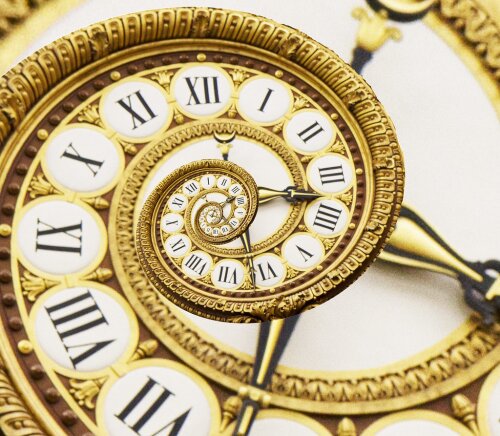
While this labelling is not entirely arbitrary - the weather in August 2023 will be more like the weather in August 2022 than in January 2022 - there could be other ways to cut up time in convenient little entities. In fact, we had such an alternative organisation of time ourselves roughly 500 years ago, as becomes apparent from the merchant correspondence of the Johnson family business. In the 1540s, the Johnson family was active in the cloth and wool trade between London, Calais and Antwerp. Due to their bankruptcy in 1553, most of their correspondence has been preserved. To get a grip on their sense of time, I exhaustively searched 167 randomly selected letters and kept track of all temporal references I could find.
As I was annotating, it soon became apparent that the Johnsons use different temporal reference frames for different aspects of their life. Like we do now, the datelines in their letters often contains full dates, like “the v daye of February”. Similarly, when they write about which letters they've received, they often use dates to distinguish them. This makes sense from a practical point of view: the main business associates wrote each other multiple times a week, so it is simply convenient for them to embed the letters in a temporal framework that caters for great precision, like dates do.
For their day-to-day business operations, however, the Johnsons use a temporal reference frame based on holidays instead. Their (business) year was conceptually divided into four quarters, roughly corresponding to the four seasons. Each quarter started with a quarter day (Our Lady Day (25/3), Midsummer (24/6), Michaelmas (29/9) and Christmas (25/12)) and was cut in half by a cross-quarter day (Candlemas (2/2), May Day (1/5), Lammas Day (1/8) and All Hallows (1/11)). In the 165 letters I analysed, I found 57 mentions of quarter days and 9 of cross-quarter days. These days were used as temporal anchors for a variety of activities: often as due dates of bills of exchange, but also as appointments for meetings or deadlines to have sold goods by. This doesn't mean that all the activities took place precisely on the (cross) quarter days - some activities were scheduled “the weke aftar Owre Lady’s daie” – but most of their business life was talked about in relation to these holidays.
Of the two temporal reference frames the Johnsons used, only one survived. Interestingly though, the two timeframes are fairly alike in terms of “cyclicality”. Whether one uses 12 months or 8 holidays as annually recurring temporal anchors matters much less than the simple fact that the anchors are recurring. This is especially so in light of the argument that the temporality of everyday life was more cyclical in the middle ages than it is now. What the temporal references in the a Johnson letters reveal above all is that various frames of temporality can happily coexist in the minds of Early Modern Englishmen and that the alleged shift from cyclical to linear isn’t as – well – linear as it first looks like.
In other words: circles are important, in history as well as mathematics, especially on a day like this. Now go and enjoy a pie!
Between routines and uncertain futures
While taking care of his children during the plague of 1533/34 in the South German town of Nördlingen, Margaretha Tucher wrote to her cousin Linhart Tucher (1487-1568): “We all thank you very much for the cask you sent us; we will not let the figs go mouldy. […] I immediately offered Lorenz Tucher to send him as many as he wants, but he said he would come over if he needed some. I sent a basket to Martin [Tucher] as he has not received any of them yet; I sent 10 pounds of almonds and 2 baskets of figs to [our neighbour] Rummel, who accepted them with many thanks, and 4 pounds of almonds and 2 baskets [of figs] to the two monks in the monastery; [I also sent] 4 pounds of almonds and 1 basket [of figs] to Doctor Baumann because he has been so comforting to me: When one of the children got sick, I went to him, and he gave me much good advice […]; when the man [in the house] next to me died, he told me what to do and what to give to the children; and I also sent 2 baskets [of figs] to the woman who brings us the milk because she does us a great service with the milk since it is not easy to get it here and she […] always gave it to us for less than the usual”. [1]
As long-distance merchants, the Tucher family had privileged access to consumer goods most of their contemporaries had not. The letters and accounts sent by the family members and agents in Lyon, Geneva or Venice do not only deal with aspects of their own trade but regularly mention goods that were ordered by Linhart for himself, that is, not for the Tucher trading company. Amongst other things, he ordered food that was exotic for German consumers, for example, figs, almonds and dates, as well as different sorts of high-quality cloth such as velvet or atlas. These goods were partially for their own household, but a large part – food in particular – was systematically distributed among their wider network as gifts. Hence, stocks of these goods were prepared in advance. In the correspondence, such routinised exchanges did not need much attention apart from information about the quantities, when the good was sent off and a confirmation after it had arrived at its destination.
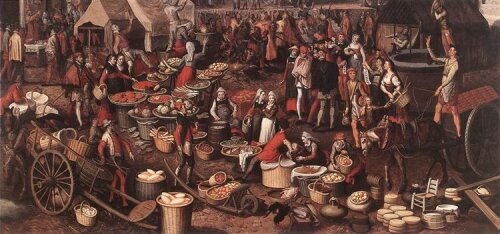
Market scene by Pieter Aersen (1550)
URL: https://www.wikiart.org/en/pieter-aertsen/market-scene-1550
While figs were relatively easy to acquire for the Tuchers on a regular basis, more individual wishes could be more challenging and time-consuming to fulfil. In a letter from 22 November 1531, for example, Anthoni V Tucher (1510-1569), a younger relative of Linhart Tucher working for the family company in Lyon, announced that he wanted to buy a necklace for his new sister-in-law. The following letters only mention that he had not been able to find something he liked either in the city or at the fair. Only in May 1532, six months later, he informed Linhart that the Tuchers’ factor Linhart Rottengatter had bought a necklace. [2] A little later, on 4 November 1532, Anthoni wrote to Linhart that he had not yet been able to buy “a short blade” for a rapier that Linhart had ordered. Exactly one month later, Anthoni sent an update that he had now found a suitable blade with the desired features and would send it to Nuremberg together with this letter. Unfortunately, the messenger left the blade behind in Geneva – which turned up again in January 1533 in Lausanne (on the other side of Lake Geneva) and was sent by another family member, Sebald Tucher, to Nuremberg. [3]
What does all this have to do with the history of the future? At first sight, not much. When we think of ‘the future’, most of us probably think of grand events, fundamental changes, hopes for a different society, or apocalyptical expectations. But ‘the future’, in the sense of ‘what has not yet happened’, is also present on a much smaller scale, namely, in everyday life expectations, intentions and plans of individuals. A large part of everyday life’s future orientation is stabilised in routines and taken as self-evident – hence, there is no need for much attention. But routines are often fragile: small changes in the ordinary flow of events and practices, quickly disturb the stability of the typical and demand plans instead of the routine practice: A certain, unquestioned future outlook becomes a less certain future as a goal has to be redefined and/or the steps to reach the goal have to be newly arranged. The examples from the Tucher correspondence thus illustrate the nuanced relations between routine practices and individual plans, in other words, between certain and uncertain futures as they shape everyday life experiences. As a source for the history of the future, such letters allow us to move beyond the scale of past future outlooks of entire societies or cultural narratives and to focus on the details of certain and uncertain futures in the everyday lives of past groups and individuals, their configurations in different domains of life and, as far as the surviving sources admit, of different layers of society.
Further reading:
- Martin Diefenbacher and Stephan Kley, Tucherbriefe. Eine Nürnberger Patrizierfamilie im 16. Jahrhundert, Nürnberg 2008. (Introduction to the Tucher family and their letters, in German)
- Christian Kuhn, ‘Generational Discourse in Urban Youth Images’, The History of the Family 15, 3 (2010), 348-363. (Analyses the Tucher correspondence as a strategy for long-term stabilisation)
- Mustafa Emirbayer and Ann Mische, ‘What Is Agency?’, American Journal of Sociology 103, 4 (1998), 962-1023. (Discusses, among other things, the relation between routines and future orientation in sociological theories of action)
[1] Stadtarchiv Nürnberg E 29/IV Nr. 978.
[2] Stadtarchiv Nürnberg E 29/IV Nr. 48-51, 53.
[3] Stadtarchiv Nürnberg E 29/IV Nr. 54, 55, 57.
Blissful, Healthy & Profitable … New Year's Wishes From the Past
By Sanne Hermans
29/12/2022
Many of us would agree that New Year's Eve involves a certain kind of magic, the sensation as if we can put the negativity behind us and try (again) to achieve our lifestyle, romantic, or career goals. We review the past year and set intentions for the coming. According to tradition, people wish each other all the best for the year ahead. In light of future thinking, these New Year’s wishes can be seen as hopeful statements – a positive push towards something – with a temporal horizon of one year. From a historical perspective, these formulaic future statements may tell us something about the socio-cultural backgrounds of the individuals using them and their interpersonal relationships. In this blog post, I want to glimpse these persisting formulas from the various merchant correspondences we consult for our project.

Postcard wishing "Happy New Year" by Frances Brundage, 1910.
Starting with the oldest, the Datini Correspondence (Italian) from around 1400 sadly yields no results. This could be because the city-states (i.e., Venice, Florence, Genoa) used different calendars, resulting in a complex system in which people scattered across Italy lived in dissimilar years. Therefore, the oldest New Year’s wish encountered derives from the Tucher Correspondence (German). On 10 January 1520, Hieronymus Tucher in Lyon wrote to his cousin Anthony II Tucher in Nuremberg the following (translated):
“May Christ the newly born, our Savior, grant you and me a blissful new year [ein gluck seligs neuys Iar] for soul and body, amen.”
The same correspondence also contains a New Year’s greeting that, from our perspective, seems relatively late. On 3 March 1528, Hiernomymus Reichel in Venice writes to his friend Lennart II Tucher in Nuremberg (translated):
“I wish you mercy and peace with a blissful new year [Einen gluckt selligen neuhen Iar] to all our souls’ salvation, amen.”
The two-month difference between these similar wishes might be due to the various calendars used in Europe at the time. As said, the Italian city-states had their own systems in place. Venice, where Hieronymus Reichel lived, celebrated the Venetian year on the first of March, continuing the ancient Roman custom until 1797. The next is from the Johnson Correspondence (English). On 29 December 1551, Sir Ambrose Cave in Duddeston ended his letter to family friend John Johnson with a New Year’s wish, not for one but many years to come:
“As knowithe the Lord, Who giff you all your good desyers, with a good newe yere and many. Written in hast, as apperithe, the xxix daye of December.”
On 2 February 1578, the Dutch merchant Gaspar Cunertorf residing in Lisbon send a letter to his partner Jan Janssen in Kampen, opening with (translated):
“Honourable, favourable friend, Joan Janss, wishing you a blissful new year [gelugkzalich nieuwe jaer]. This is to inform you that we are all very surprised that we have not received any letters from you in 3 months, […].”
The date of writing has relatively long since passed the new year, but considering their previous correspondence dated 8 November, there had been no earlier opportunity to wish a happy New Year. It is also noticeable that there is no reference to God or Christ present. Incidentally, this is only sometimes the case. In another letter, dated 8 January 1578, Gaspar wrote to his agent Adriaan Speelman in Antwerp (translated):
“Hereby commanding God Almighty who wishes to spare you and all your family in long health and grant you a blissful New Year [ghelucksalich nieuwe jaer].”
It is more often in these closing formulas that references to the divine are made. So the place in the letter can be essential in understanding why a New Year’s greeting is infused with health formulas, Christian ritual formulas, or both. Of course, it may also have to do with the relationship between correspondents, which in this case is hierarchical. In another Dutch correspondence, that of the Family Thijs, we encounter a lengthier New Year's wish in the opening of a letter from 2 January 1600 (translated):
“With heartfelt greetings and wishing you a happy and blessed new year [frolyck ende salyck niewe Jaer] and all that is good. I cannot resist writing you this little letter, even though I have not heard from you in a long time, which surprises me very much. I pray and urge you to be a bit more diligent in your writing this new year and to inform us of your good health often.”
Written by Hedwig de Baccher from Hamburg to her brother Samuel in Amsterdam, this extensive greeting must be placed in the context of the plague sweeping through Western Europe at the time. Hedwig's fears were well-founded as the epidemic reached their father in Halberstadt during the summer of 1600. Fortunately, he made a full recovery. One year later, on 8 January 1601, her wish is more subdued, perhaps indicating that the scare of the epidemic may no longer be as prominent as the year before:
“A Blissful New Year [gelucksalig Nieue Jaer], kind, dear brother. This little note is to inform you of our good health; hoping to hear the same from you.”
The greetings by the Dutch correspondents contain the same adjective as the German: blissful (gelukzalig). Forwarding a century and a half, the last wish discussed derives from the Roux Correspondence (French). Françoise Datour in Saint-Malo writes to a her business correspondent Jean-Baptiste Honoré Roux in Marseille on 27 December 1741:
“As this letter will arrive in the new year, my son and I wish you and your dear family the happiest new year and long prosperity in your enterprises [des plus heureuses et une longue suitte de prospérité dans vos entreprises].”
In this New Year's greeting, economic prosperity is placed beside the usual desire for happiness, which is new compared to the other formulations. Still, not surprising as this letter should be viewed in a mercantile setting.
The above examples show, on the one hand, that there were remarkable similarities in formulating New Year's wishes between time and space and, on the other, that there are indeed some subtle differences. For instance, New Year’s wishes can be located at the beginning or the end of a letter; with and without references to the divine. Incidentally, this may also be a sign of the times, a phenomenon that will be further explored by Sara and Elisabeth through these and other future statements. Lastly, they may refer to happiness, health, or prosperity but depending on the situational and relational context; one desire may receive more focus than another.
This post ends with a very last greeting in the present, namely from our team to you, the reader: a Happy New Year, and may all your future goals be realised.
Source image: https://commons.wikimedia.org/wiki/File:PostcardHappyNewYearOldManKidScytheHourglass1910.jpg last consulted 28/12/2022.
More about New Year’s traditions:
… of the Middle Ages:
· https://www.medievalists.net/2015/12/celebrating-the-new-year-medieval-style/
· https://www.medievalists.net/2016/01/a-medieval-guide-to-predicting-the-year/
… of the Early Modern Period:
· Sophie Cope, “Making the New Year: Dated Objects and the Materiality of Time in Early Modern England,” Journal of Early Modern Studies 6 (2017): 89-112. Link: https://oajournals.fupress.net/index.php/bsfm-jems/article/view/7078
A House Built of Gold and Future
By Nicolò Zennaro
05/12/2022
In Venice on the 23rd of September 1845, John Ruskin (1819-1900), a famous writer and art critic, writes a letter to his father. He complains to him about something that happened the day before and touched his very soul. John had seen how the city government was carrying out a restoration project which he perceived as an act of destruction to the detriment of a work of extreme beauty. The hammer blows of some workmen were undoing the façade of one of the most sumptuous and beautiful palaces on the Grand Canal in front of Ruskin, who felt compelled to make a watercolour sketch of that splendour that was unravelling on the ground. The building concerned is the Ca' d'Oro, or House of Gold, located in the sestiere of Cannareggio.
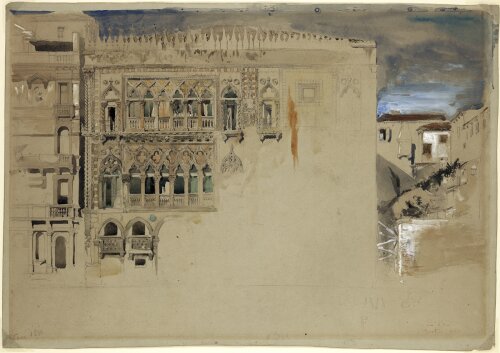
Ca d'Oro by John Rushkin, 1845.
The blows of the hammers were not just hitting the palace’s façade. They were reshaping the materialisation of the will of a man who spent his entire life, his experience and capital on uncertain risks and investments to realise his expectation of an ideal future. I am not talking about Marino Contarini (1385-1441), the patrician and businessman who commissioned the construction of the Ca' d'Oro between 1420 and 1434. He was enabled in this venture not by his trading skills or political planning but by the aspirations of his father, Antonio Contarini (c.1353-1441). Antonio developed the small family's business, making them a reference point in the international wool and spice trade. Moreover, it was he who increased the Contarini's political power to such an extent that he was among the candidates for doge in the 1423 election and enabled the marriage between Marino and Soradamor Zeno (1406), which earned him the ownership of the palace that was partially demolished and integrated into the construction of the Ca' d'Oro.
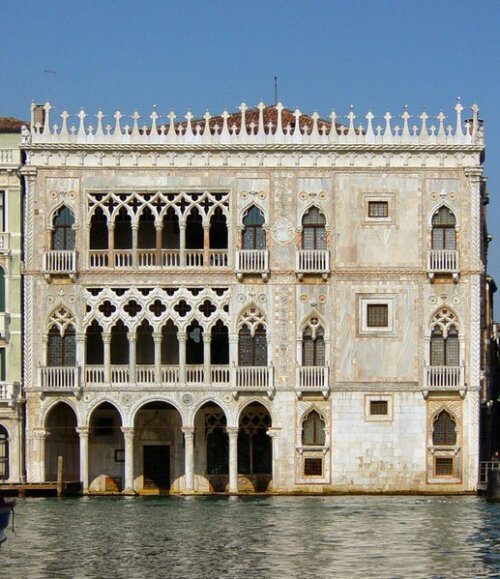
It is easy to trace Marino's life but not his father's. The main reason behind this difficulty is the widespread homonymy traceable in the documents of the period. The lists of the 1378 Estimo presents as many as 68 heads of families -11 of whom were female- with the surname Contarini. In 1512, Marin Sanudo (1466-1536), a Venetian politician and humanist, still counted 38 males, mainly concentrated in the parishes of San Silvestro (19 members) and Santi Apostoli (15 members). This lineage also appears inextricably linked to the events of the Chioggia War (1379-1381): one of their members, Andrea Contarini, ruled during this conflict from 1368 to 1382. Most of the information we have comes from his political activity, which took off in 1409 when he was selected as ambassador to visit the Croatian city of Zara, part of the Venetian domains, and the Pope in Rome. In 1414 he was elected as Procurator of St. Mark, one of the city's highest offices. A portrait of him hung in the hall of the Maggior Consiglio in the Ducal Palace.
Despite the importance of this man in the political and economic dynamics of Venice, the Archivio di Stato di Venezia has no sources on his activities as a merchant. To reveal this fundamental part of his life, it is necessary to move from the lagoon to Prato, a city not far from Florence. Here is the house of Francesco di Marco Datini (c. 1335-1410), a Tuscan merchant who became famous thanks to Iris Origo's novel, The Merchant of Prato (1957). This building is now housing the Archivio di Stato di Prato, which preserves around 150,000 letters and hundreds of account books relating to his holding company. Among these correspondences is that of Antonio Contarini, the man behind the House of Gold. My project will study his 210 letters written between 1397 and 1406 to understand how this businessman thought and conceived his future. This will allow us to know how his expectations were reflected in his choices, which later became the foundations of the palace of the Ca' d'Oro.
This palace, deprived of lapis lazuli and gold leaf, can still be admired and visited today. Since 1927, it has been used as a museum and houses the Giorgio Franchetti Gallery, which preserves several masters of Venetian art history, such as Carpaccio, Mantegna and Titian. A palace, conceived as the materialisation of a single individual’s future expectations and hopes, now stands in front of the Grand Canal as one of the cornerstones for understanding the past and culture of an entire city.
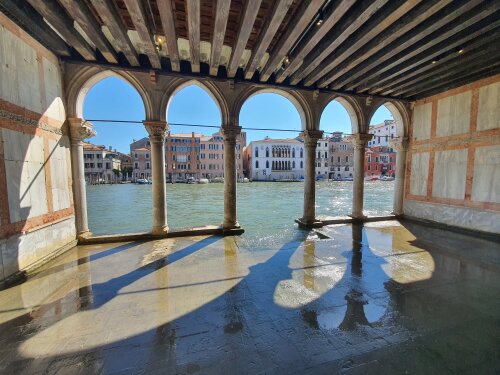
For more on this topic, see:
· Goy, Richard John. The House of Gold: Building a Palace in Medieval Venice. Cambridge: University Press, 1992.
· Mozzato, Andrea. ‘Una Preziosa Materia Prima. La Lana Spagnola a Venezia Tra Tre e Quattrocento’. Archivio Veneto, 2008, 25–58.
· Arslan, Edoardo, Venezia gotica: l’architettura civile gotica veneziana, Milano, Electa, 1979, pp. 225-237.
How current events and present ideas on the future shed light on the historical research of the Back to the Future project
by Jeroen Puttevils
15/11/2022
I have long been pondering (with some dread even) about a good subject for this first blog post. But then two opportunities presented themselves last week: Elon Musk took over Twitter, causing a huge exit of Twitter users, and FTX, a Bahamas-based exchange for cryptocurrency, filed for bankruptcy. So what does this have to do with the history of the future – the subject of this blog? Well, both Musk and the former CEO of FTX Sam Bankman-Fried are strong advocates of longtermism, as all kinds of investigative pieces on Musk and Bankman-Fried produced around their respective controversies have shown.
Longtermism is a philosophy that emphasizes the long-term future of humankind. Longtermists argue that people in the future matter as much as we do now and because there might be more people alive in the future than now, they should be taken into account when we take decisions today. Key proponents of longtermist philosophy are Toby Ord, Nick Bostrom and William MacAskill. Longtermists argue that we have to act in our present to avoid catastrophes that obliterate potential future generations, such as pandemics, nuclear wars, potentially dangerous artificial intelligence and climate change. (A good place to start reading is the Wikipedia page on longtermism, although it is not very critical).
Now, at first sight, one cannot be against such measures. However, Émile P. Torres (whose very interesting work you can follow on Émile P. Torres 🏳️⚧️ (@xriskology) / Twitter and on Émile P. Torres (@xriskology@mastodon.bida.im) - Mastodon) provides serious grounds for suspicion about the longtermism movement. In a number of highly recommended pieces that Torres wrote for Aeon (Why longtermism is the world’s most dangerous secular credo | Aeon Essays) and Salon (Émile P. Torres's Articles at Salon.com) he shows how well-funded longtermism has become thanks to financiers as Musk and Bankman-Fried. Moreover, the vision of longtermism is embraced by tech moguls; their funds and influence contribute to the evangelization of the movement’s ideas. Bankman-Fried, for example, has been particularly vociferous about longtermist thinking (https://www.vice.com/en/article/dy7epm/sam-bankman-fried-was-supposed-to-be-different-he-wasnt).

Add to that the emphasis of longtermism put on potential future generations which should be enabled by acting in our present. This makes some longtermists argue that we should only help present humankind to the extent that future generations are made possible. There has also been criticism of longtermism’s stance vis-à-vis climate change: longtermist views tend to discount the short-term economic effects of climate change. Musk’s spaceX program contributes directly to the emission of greenhouse gases today. The production of cryptocurrencies, traded at Bankman-Fried’s FTX, requires vast amounts of electricity. So, key activities of both visionaries have a profound effect on climate change, but they will probably discount this in view of a longer-term future. The ends justify the means?
Hence, one should treat this philosophy with the utmost care and scrutiny. It is fascinating as a historian working on histories of the future to read about longtermist ideas for several reasons. The features of these ideas are now particularly clear because of the spotlights on Musk and Bankman-Fried– many longtermists are now actively cutting their ties with Bankman-Fried and FTX, for example (https://twitter.com/willmacaskill/status/1591218014707671040).
First, longtermism explicitly thinks about the future and quickly arrives at ideas of human extinction. The near future is not of immediate interest and that has obvious historical parallels with all kinds of apocalyptic ideas. Secondly, in longtermism we see a clear nexus between a distant future and acting in the present. Third, the longtermist ideas of the future ended up in circles of power and influence. Obviously, ideas about the future are inherently political and those who are in power and/or have considerable influence because of their wealth thus have a big effect on the relationship between acting in the present and thinking about the future.

Caption: The Clock of the Long Now or the 10,000-year clock, paid for by Jeff Bezos.
These three points closely mirror the agenda of the Back to the Future project. We consider different layers and types of future thinking through and consider, for example, how ideas about End Times fed into thinking about the future and affected actions in the historical present. Another line of research we pursue is the range of different future horizons: not only the very distant future but also near-future short-term speculation like the activities at the now-bankrupt FTX or price speculation on the arrival of the new fleet from India in the sixteenth century or the effect of epidemics on people’s future expectations. We are also ever more aware of the power dynamics behind images and ideas of the future in the past. The dynamics between collective and individual imagined futures also reveal such power play: is Elon Musk like the medieval church, indoctrinating the faithful with his view of the future? Moreover, future thinking explains investment decisions today, such as buying Twitter or setting up an exchange for crypto, but it also can help us understand the economies and societies of the past: how did future thinking affect decisions and actions in the past? This blog takes us and you on this journey to the past, to the histories of the future. I hope the journey can provide us with insights into the past, the present and our future.
PS
After writing this blog, several newspapers and magazines published new pieces on the connection between longtermism, effective altruism which has close ties to longtermism, Musk and Bankman-Fried:
Elon Musk's useful philosopher - New Statesman
The good delusion: has effective altruism broken bad? | The Economist
FTX debacle casts an unforgiving light on effective altruism | Financial Times